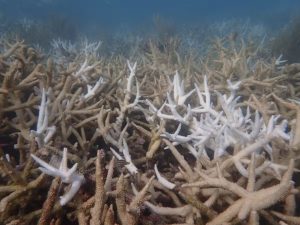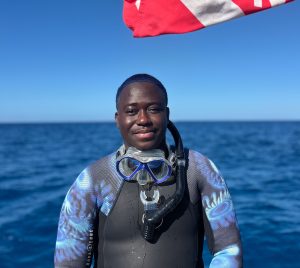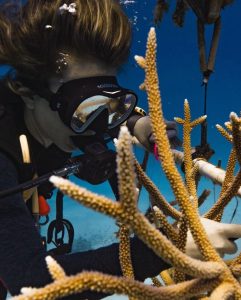
Lack of regulations and increased fishing pressure likely to blame
Herbivorous parrotfish play critical ecological functions in sustaining resilient coral reefs which protect coastlines, provide food and support livelihoods. However, in The Bahamas, parrotfish are increasingly being targeted and to date, no fishery regulations have been implemented.
Assessing the distribution, diversity, abundance and habitat use of parrotfish are important for preserving coral reefs and to provide input for managing fishing pressure on their populations.
The Perry Institute for Marine Science (PIMS) is excited to share that Dr. Krista Sherman, Maya Gomez, Thomas Kemenes and Dr. Craig Dahlgren recently published a new open access article entitled, “Spatial and Temporal Variability in Parrotfish Assemblages on Bahamian Coral Reefs”, in the journal Diversity.
PIMS has been monitoring the status of reefs throughout The Bahamas for decades using Atlantic & Gulf Rapid Reef Assessment (AGRRA) surveys. Our team analyzed AGRRA data collected between 2011 and 2019 to examine the status of parrotfish populations across 26 reefs around two islands in The Bahamas; New Providence and Rose Island. We also sought to determine whether the growing fishery has impacted parrotfish populations.
Key findings revealed a 59% decline in parrotfish density and noticeable changes in size composition over time, with a shift to smaller size fish and loss of large adults across reef sites. The authors reported that “only 3% of parrotfish were large/terminal phase adults”. These changes were evident in both ecologically important parrotfish species as well as others that are being caught for subsistence and commercial fishing.

So why is this alarming? Parrotfish populations in The Bahamas have typically been among the most abundant in the Caribbean, but these latest results demonstrate that mean densities around many (58%) of the reefs surveyed are now lower than regional values with significant declines occurring in a few parrotfish species. Additionally, large parrotfish are known to be more effective at grazing (i.e. removing macroalgae) than smaller fish, so the loss of these large herbivores has implications for the condition or health of coral reefs habitats.
Dr. Sherman, lead author and Senior Scientist for PIMS’ Fisheries Research & Conservation Program, said, “Our results highlight the importance of monitoring and emphasize the urgency of implementing science-based strategies to sustainably manage the fishery and protect these ecologically essential herbivores, which are vital components of coral reefs.”
To learn more about the suggested management recommendations and additional results read the paper and visit perryinstitute.org.

“Seafood Nation” Documentary Premiere Explores the Heart of Bahamian Culture and the Future of Fisheries
NASSAU, The Bahamas | December 5, 2025 – From the bustling stalls of Potter’s Cay to family kitchen tables across the archipelago, seafood is far more than just sustenance in

PIMS and Disney Conservation Fund Partner to Train 19 Government Divers
PIMS dive training in Nassau strengthened national coral restoration capacity across government agencies. Bahamas Dive Training Builds National Coral Restoration Capacity Last fall, between the months of September and October,

Florida’s Coral Reef Crossed a Line: What Functional Extinction Really Means for Elkhorn and Staghorn Corals
Reefs didn’t just bleach. They functionally vanished in one summer. A new Science study co-authored by researchers from the Perry Institute for Marine Science (PIMS) has found that Florida’s two

Q&A: Understanding the IDC Course at PIMS with Duran Mitchell
A former aquarist turned coral conservationist, Duran is passionate about understanding how all marine life connects. PIMS & IDC: Empowering New Dive Instructors for Marine Conservation PIMS & IDC: Empowering

Forbes Shines a Spotlight on Coral Reef Restoration in the Caribbean
When Forbes highlights coral reef restoration, it signals something powerful: the world is paying attention to the urgent fight to protect reefs. And solutions are within reach. Recently, Forbes featured Dr. Valeria

New Reef Rescue Diver Course: Volunteer in Coral Reef Restoration Abroad
Coral reefs are often called the rainforests of the sea—complex ecosystems that shelter a quarter of all marine life, feed millions of people, protect coastlines from storms, and attract travelers



